
A | B | C | D | E | F | G | H | CH | I | J | K | L | M | N | O | P | Q | R | S | T | U | V | W | X | Y | Z | 0 | 1 | 2 | 3 | 4 | 5 | 6 | 7 | 8 | 9
| Wild boar Temporal range: Early Pleistocene–Holocene
| |
|---|---|

| |
| Male Central European boar (S. s. scrofa) | |
| Scientific classification | |
| Domain: | Eukaryota |
| Kingdom: | Animalia |
| Phylum: | Chordata |
| Class: | Mammalia |
| Order: | Artiodactyla |
| Family: | Suidae |
| Genus: | Sus |
| Species: | S. scrofa
|
| Binomial name | |
| Sus scrofa | |

| |
| Reconstructed native range of wild boar (green) and introduced populations (blue) except in the Caribbean, New Zealand, sub-Saharan Africa, and elsewhere in Bermuda, Northern Canada and Alaska.[1] | |
| Synonyms | |
|
List
| |
The wild boar (Sus scrofa), also known as the wild swine,[4] common wild pig,[5] Eurasian wild pig,[6] or simply wild pig,[7] is a suid native to much of Eurasia and North Africa, and has been introduced to the Americas and Oceania. The species is now one of the widest-ranging mammals in the world, as well as the most widespread suiform.[5] It has been assessed as least concern on the IUCN Red List due to its wide range, high numbers, and adaptability to a diversity of habitats.[1] It has become an invasive species in part of its introduced range. Wild boars probably originated in Southeast Asia during the Early Pleistocene[8] and outcompeted other suid species as they spread throughout the Old World.[9]
As of 2005[update], up to 16 subspecies are recognized, which are divided into four regional groupings based on skull height and lacrimal bone length.[2] The species lives in matriarchal societies consisting of interrelated females and their young (both male and female). Fully grown males are usually solitary outside the breeding season.[10] The wolf is the wild boar's main predator in most of its natural range except in the Far East and the Lesser Sunda Islands, where it is replaced by the tiger and Komodo dragon respectively.[11][12] The wild boar has a long history of association with humans, having been the ancestor of most domestic pig breeds and a big-game animal for millennia. Boars have also re-hybridized in recent decades with feral pigs; these boar–pig hybrids have become a serious pest wild animal in the Americas and Australia.
Terminology
As true wild boars became extinct in Great Britain before the development of Modern English, the same terms are often used for both true wild boar and pigs, especially large or semi-wild ones. The English boar stems from the Old English bār, which is thought to be derived from the West Germanic bair, of unknown origin.[13] Boar is sometimes used specifically to refer to males, and may also be used to refer to male domesticated pigs, especially breeding males that have not been castrated.[14][15]
Sow, the traditional name for a female, again comes from Old English and Germanic; it stems from Proto-Indo-European, and is related to the Latin: sus and Greek hus, and more closely to the New High German Sau. The young may be called piglets or boarlets.[16]
The animals' specific name scrofa is Latin for 'sow'.[17]
Hunting
In hunting terminology, boars are given different designations according to their age:[18]
| Designation | Age | Image |
|---|---|---|
| Squeaker | 0–10 months | 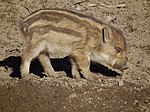
|
| Juvenile | 10–12 months | 
|
| Pig of the sounder | Two years | |
| Boar of the 4th/5th/6th year | 3–5 years | 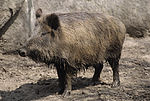
|
| Old boar | Six years | |
| Grand old boar | Over seven years | 
|
Taxonomy and evolution
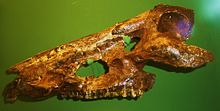
MtDNA studies indicate that the wild boar originated from islands in Southeast Asia such as Indonesia and the Philippines, and subsequently spread onto mainland Eurasia and North Africa.[8] The earliest fossil finds of the species come from both Europe and Asia, and date back to the Early Pleistocene.[19] By the late Villafranchian, S. scrofa largely displaced the related S. strozzii, a large, possibly swamp-adapted suid ancestral to the modern S. verrucosus throughout the Eurasian mainland, restricting it to insular Asia.[9] Its closest wild relative is the bearded pig of Malacca and surrounding islands.[4]
Subspecies
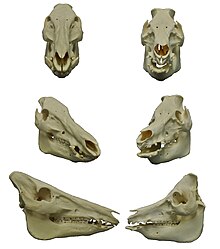
As of 2005[update], 16 subspecies are recognised, which are divided into four regional groupings:[2]
- Western: Includes S. s. scrofa, S. s. meridionalis, S. s. algira, S. s. attila, S. s. lybicus and S. s. nigripes. These subspecies are typically high-skulled (though lybicus and some scrofa are low-skulled), with thick underwool and (excepting scrofa and attila) poorly developed manes.[21]
- Indian: Includes S. s. davidi and S. s. cristatus. These subspecies have sparse or absent underwool, with long manes and prominent bands on the snout and mouth. While S. s. cristatus is high-skulled, S. s. davidi is low-skulled.[21]
- Eastern: Includes S. s. sibiricus, S. s. ussuricus, S. s. leucomystax, S. s. riukiuanus, S. s. taivanus and S. s. moupinensis. These subspecies are characterised by a whitish streak extending from the corners of the mouth to the lower jaw. With the exception of S. s. ussuricus, most are high-skulled. The underwool is thick, except in S. s. moupinensis, and the mane is largely absent.[21]
- Indonesian: Represented solely by S. s. vittatus, it is characterised by its sparse body hair, lack of underwool, fairly long mane, a broad reddish band extending from the muzzle to the sides of the neck.[21] It is the most basal of the four groups, having the smallest relative brain size, more primitive dentition and unspecialised cranial structure.[22]
| Subspecies | Image | Trinomial authority | Description | Range | Synonyms |
|---|---|---|---|---|---|
| Central European boar S. s. scrofa Nominate subspecies |
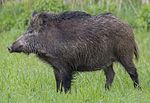
|
Linnaeus, 1758 | A medium-sized, dark to rusty brown-haired subspecies with long and relatively narrow lacrimal bones[4] | Much of continental Europe and into Eurasia |
|
| North African boar S. s. algira | 
|
Loche, 1867 | Sometimes considered a junior synonym of S. s. scrofa, but smaller and with proportionally longer tusks[37] | Tunisia, Algeria and Morocco | barbarus (Sclater, 1860) sahariensis (Heim de Balzac, 1937) |
| Carpathian boar S. s. attila | 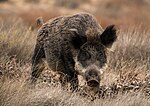
|
Thomas, 1912 | A large-sized subspecies with long lacrimal bones and dark hair, though lighter-coloured than S. s. scrofa[4] | Romania, Hungary, Ukraine, the Balkans, the Caucasus, Transcaucasia, the Caspian coast, Asia Minor and northern Iran | falzfeini (Matschie, 1918) |
| Indian boar S. s. cristatus | 
|
Wagner, 1839 | A long-maned subspecies with a coat that is brindled black unlike S. s. davidi,[38] it is more lightly built than S. s. scrofa. Its head is larger and more pointed than that of S. s. scrofa and its ears smaller and more pointed. The plane of the forehead is straight, while it is concave in S. s. scrofa.[39] | India, Nepal, Burma, western Thailand, Pakistan and Sri Lanka | affinis (Gray, 1847), aipomus (Gray, 1868), aipomus (Hodgson, 1842), bengalensis (Blyth, 1860), indicus (Gray, 1843), isonotus (Gray, 1868), isonotus (Hodgson, 1842), jubatus (Miller, 1906), typicus (Lydekker, 1900), zeylonensis (Blyth, 1851) |
| Central Asian boar S. s. davidi | 
|
Groves, 1981 | A small, long-maned and light brown subspecies[38] | Pakistan and northwestern India to southeastern Iran | |
| Japanese boar S. s. leucomystax | 
|
Temminck, 1842 | A small, almost maneless, yellowish-brown subspecies[38] | All of Japan, save for Hokkaido and the Ryukyu Islands | japonica (Nehring, 1885) nipponicus (Heude, 1899) |
| Anatolian boar S. s. libycus | 
|
Gray, 1868 | A small, pale and almost maneless subspecies[38] | Transcaucasia, Turkey, Levant and the former Yugoslavia | lybicus (Groves, 1981) mediterraneus (Ulmansky, 1911) |
| Maremman boar S. s. majori | 
|
Zdroj:https://en.wikipedia.org?pojem=Wild_boar

